Caloocan
Caloocan, officially the City of Caloocan (Filipino: Lungsod ng Kalookan; IPA: [kalɔˈʔokan]), is a 1st class highly urbanized city in Metro Manila, Philippines. According to the 2020 census, it has a population of 1,661,584 people[3] making it the fourth-most populous city in the Philippines.
Caloocan
Kalookan | |
|---|---|
| City of Caloocan | |
_01.jpg.webp) .jpg.webp)     (From top, left to right: Bonifacio Monument • Caloocan City Hall • La Loma Cemetery • San Roque Cathedral-Parish • Caloocan Sports Complex • Thai To Taoist Temple) | |
 Flag 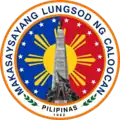 Seal | |
| Motto: Aksyon at Malasakit | |
| Anthem: "Mabuhay ang Caloocan" | |
 Location of Caloocan within Metro Manila | |
OpenStreetMap | |
.svg.png.webp) Caloocan Location within the Philippines | |
| Coordinates: 14°39′N 120°58′E | |
| Country | Philippines |
| Region | National Capital Region |
| Province | none |
| District | 1st to 3rd district |
| Founded | 1815 |
| Cityhood | February 16, 1962 |
| Highly urbanized city | December 22, 1979 |
| Barangays | 188 (see Barangays) |
| Government | |
| • Type | Sangguniang Panlungsod |
| • Mayor | Dale Gonzalo Malapitan (PDP-Laban) |
| • Vice Mayor | Anna Karina Teh-Limsico (NP) |
| • Representatives |
|
| • City Council | Members |
| • Electorate | 700,279 voters (2022) |
| Area | |
| • Total | 55.80 km2 (21.54 sq mi) |
| Elevation | 30 m (100 ft) |
| Highest elevation | 514 m (1,686 ft) |
| Lowest elevation | −2 m (−7 ft) |
| Population (2020 census)[3] | |
| • Total | 1,661,584 |
| • Rank | 4th |
| • Density | 30,000/km2 (77,000/sq mi) |
| • Households | 404,252 |
| Economy | |
| • Income class | 1st city income class |
| • Poverty incidence | 4.66 |
| • Revenue | ₱ 6,812 million (2020) |
| • Assets | ₱ 21,772 million (2020) |
| • Expenditure | ₱ 8,501 million (2020) |
| • Liabilities | ₱ 9,939 million (2020) |
| Service provider | |
| • Electricity | Manila Electric Company (Meralco) |
| Time zone | UTC+8 (PST) |
| ZIP code | 1400–1413, 1420–1428 |
| PSGC | |
| IDD : area code | +63 (0)02 |
| Native languages | Tagalog |
| Website | caloocancity |
Caloocan is divided into two geographical locations with a total combined area of 5,333.40 hectares (13,179.1 acres). It was formerly part of the Province of Rizal in southern Luzon. It comprises what is known as the CAMANAVA area along with the cities of Malabon, Navotas and Valenzuela.
South Caloocan is bordered by Manila, Quezon City, Malabon, Navotas and Valenzuela. The presence of commercial and industrial activities combined with residential areas make it a highly urbanized central business district and a major urban center in the Northern District of Metropolitan Manila.[5] North Caloocan shares its border with Quezon City and Valenzuela, Marilao, Meycauayan and San Jose del Monte in the province of Bulacan, and Rodriguez in the province of Rizal. It is composed of mostly residential subdivisions and extensive resettlement areas with scattered distribution of industrial estates mostly within road transit points and intersections.[5]
Etymology
Caloocan as a toponym comes from the Tagalog root word lo-ok; kalook-lookan (or kaloob-looban) means "innermost area". The city's name is colloquially spelled Kalookan.
There is a mixed preference over the preferred spelling of the city's name. Variation, and the apparent confusion over the spelling, came about during the early 1970s, when a resolution was adopted by the municipal board, requiring the city departments to use the name "Kalookan." The execution of the said resolution was interrupted when the country was placed under martial law in September 1972. After the restoration of city and municipal councils, in 1988, then-councilor Aurora Asistio-Henson filed Resolution No. 006, amending the previous resolution and seeking to promote Filipino nationalism by requiring all residents and all offices and establishments in the city, "whether public or private," to spell the name of the city as "Kalookan." According to Henson, the "Filipinized spelling" provides essence and significance to the city's history, and she added that it should be used "in the city hall, the barangay halls, public markets, and other places for the information and guidance of all concerned." Nevertheless, this change in spelling was denounced by the city residents, business owners, and officials. Former representative and mayor Virgilio Robles declared the move illegal because it lacked congressional approval. He added that the city's name is spelled as "Caloocan" as shown in the city charter.[6][7] The general inclination of spelling in the city is "Caloocan" and not "Kalookan," despite the existing city ordinance, although confusion has led to varied spelling choices of many businesses throughout the city. The official logo has the city's name spelled as "Caloocan," and such spelling is favored by many barangays and public and private schools in the city. "Kalookan" is preferred by the Makati-based Directories of the Philippines Corporation (DPC), while many national newspapers and magazines, and mapmakers like the Mandaluyong-based HYDN Publishing favor "Caloocan."[8][9]
History

Spanish colonial era
Originally, Caloocan was the area where the old town of Tondo and Tambobong met, located along the shores of Dagat-Dagatan, a crescent-shaped inland lagoon to the west. The settlement along the shore was called "Aromahan", or "Espina" to the Spaniards, and was separated from Manila Bay by a narrow ridge from Tondo towards an opening in Kinabutasan leading to the sea.[10]
By the late 1700s, the fishermen of Aromahan has expanded towards a hill east of Dagat-Dagatan. This naturally stony hill was called "Kaloogan", meaning "interior territory", which evolved from the old Tagalog word "loog" (synonymous with "loob" or "inside"). The "g" sound could have shifted to the "k" sound in Tagalog phonetics (e.g. baksak > bagsak) leading to the present name of the city. With Aromahan relegated to the periphery, this hilltop area was also settled by oppressed people from Tondo, becoming the new center of the community by 1802. To the east was a vast stretch of cogon-covered land. Eventually called "Kalaanan", meaning flat grassland in old Tagalog, this area is now generally known as Grace Park.[10]
Caloocan became a municipality when it was separated from Tondo in 1815. Its original territory extended to the foothills of Marikina, San Mateo and Montalban to the east; Tinajeros, Tanza, and Tala rivers to the north; Pasig, San Juan del Monte, San Francisco del Monte, Sampalok, Santa Cruz and Tondo in the south; and Dagat-dagatan and Aromahan to the west.[11][12] The local government building was set up on the relatively well-settled portion just above Libis Espina. The old Aromahan chapel was finally abandoned and a new church was built facing the municipal hall. To escape the Spanish authorities, many from the area abandoned the town proper and sought refuge in the grasslands of Balintawak and Pugad-Lawin, in which the people fought the landlords of Hacienda de Maysilo for terrestrial rights, which went on for almost a hundred years.[10][11]
The Philippine revolution
Caloocan is historically significant because it was the center of activities for the Katipunan, the secret militant society that launched the Philippine Revolution during the Spanish occupation of the Philippines. In a house in Caloocan, secret meetings were held by Andrés Bonifacio and his men, and it was in the city's perimeters where the first armed encounter took place between the Katipunan and the Spaniards. The revolution erupted after the "Cry of Balintawak" led by Andres Bonifacio against their oppressors on August 30, 1896.
American invasion era

In 1899, the people of Caloocan showed resistance to coming to terms with the Americans, who were bent on extending their supremacy over the country. The men of Caloocan fought the new invaders on February 23, 1899, however victory eluded the local troops on the pretext of Antonio Luna's rift with Emilio Aguinaldo's loyalists.[11] The city then saw heavy fighting in the Philippine–American War, at the Battle of Caloocan and the Second Battle of Caloocan.
In 1901, under the American regime, Caloocan, previously a part of the province of Manila, became one of the municipalities of the newly established province of Rizal.[13] Due to the consolidation of several municipalities in 1903, Novaliches, then an independent municipality, became part of Caloocan pursuant to Act No. 942,[14] as amended by Act Nos. 984 and 1008 of the Philippine Commission.
Japanese occupation era
In 1942, Caloocan was one of the municipalities of Rizal merged alongside Manila and Quezon City to form the City of Greater Manila as an emergency measure by President Manuel L. Quezon.[15][16] It regained its pre-war status as a municipality of Rizal when the City of Greater Manila was dissolved effective August 1, 1945.[17]
Cityhood

In 1961, after Republic Act No. 3278 was approved by the Philippine Congress, a plebiscite was conducted.[6] Caloocan was officially inducted into cityhood on February 16, 1962.[11]
Caloocan remained a city of the province of Rizal until November 7, 1975, when it became a part of the National Capital Region or Metro Manila, by virtue of Presidential Decree No. 824.[18]
Territorial changes

Existing territorial boundaries
Detached by Commonwealth Act No. 502 (1939)
Detached by Republic Act No. 392 (1949)
Caloocan once encompassed a much larger, contiguous area. The districts of Balintawak, La Loma and Novaliches were once part of Caloocan. Balintawak is a historic district because it was the original site of the "Cry of Pugad Lawin" (Unang Sigaw sa Balintawak) at a location called "Kang-kong" near Tandang Sora's house. Novaliches was an expansive sector with some hillsides that served as meeting places and hideouts for Andrés Bonifacio and the Katipunan.
By the 1920s, there was a consolidation of several municipalities. Caloocan annexed the neighboring town of Novaliches, as stated in the Act No. 942, as amended by Act Nos. 984 and 1008 of the Philippine Commission, bringing its total area to about 1,500 hectares (3,700 acres).[11] When Commonwealth Act No. 502 created Quezon City in 1939, Caloocan ceded 1,500 hectares of land from the barrios or sitios of Bagubantay (Bago Bantay), Balintauac (Balintawák), Balingasa, Kaingin, Kangkong (present-day Apolonio Samson), La Loma, Malamig, Matalahib (present-day Santo Domingo), Masambong, Galas, San Isidro, San José, Santol and Tatalon.[19] Instead of opposing the transfer, Caloocan residents willingly gave the land in the belief it will benefit the country's new capital city.[20]
However, in 1949, Congress passed Republic Act No. 392, which redefined the Caloocan–Quezon City boundary.[21] The barrios of Baesa, Sangandaan, Talipapâ, San Bartolomé, Pasong Tamó, Novaliches Proper (poblacion), Banlat (present-day Tandang Sora), Kabuyao, Pugad Lawin, Bagbag, Pasong Putik, which once belonged to Novaliches and had an area of about 8,100 hectares (20,000 acres), were excised from Caloocan. The remaining portion of the Novaliches is now called North Caloocan. This split Caloocan into two parts: a southern section that is more urbanized, and a northern section that became suburban-rural.[22]
Geography
Caloocan is divided into two non-contiguous areas with a total combined area of 53.334 square kilometers (20.592 sq mi). South Caloocan, with an area of 13.625 square kilometers (5.261 sq mi), is bordered on the south by Manila, on the east by Quezon City, and on the north-northwest by Malabon, Navotas and Valenzuela. North Caloocan, with an area of 39.709 square kilometers (15.332 sq mi), shares its border on the south-southeast by Quezon City, on the southwest by Valenzuela, on the north by Marilao, Meycauayan and San Jose del Monte in the province of Bulacan, and on the northeast by Rodriguez in the province of Rizal.[11]
Topography

South Caloocan, where most commercial and industrial establishments are found, lies on generally flat and highly accessible land, with slopes ranging from 0–3%. The topography gradually changes from gently to moderately sloping to rolling along the North Luzon Expressway, with slopes ranging from 3–18%. The highest point at 35.00 meters (114.83 ft) above sea level can be found in this area, while the lowest point is in the southern part of Dagat-Dagatan at about 0.993 meters (3 ft 3.1 in) above mean sea level.[23]
North Caloocan is characterized by gently to steeply undulating to rolling topography with slopes ranging from 3–18%, mostly seen in the northern and central portion, gradually transforming into a southward trend of flat lands down to the southwestern tip of the boundary. Being accessible to major roads, many industrial and residential subdivisions have been developed on this near-level land.[23]
Geology
The geologic formation of the two portions of Caloocan varies in type and characteristics. and are specifically classified as quaternary alluvium, tuff and tuffaceous sediment, pyroclastic flow deposit, and conglomerates. The formation on the eastern half of Metropolitan Manila extending to the coastline of Manila Bay and including a greater part of South Caloocan is the quaternary alluvium, which consists of unconsolidated stream‐deposited sediments that include sand, silt, clay and gravel.[23]
Eastward of South Caloocan, large areas consisting of tuff and tuffaceous sediment can be traced, spreading towards the whole eastern side of Metropolitan Manila. Pyroclastic flow deposit or igneous rocks formed by the lithification of ash flow are likewise present in some northern fringes of South Caloocan and in most parts of North Caloocan. On the northeast borders of North Caloocan, conglomerate rocks were traced, crossing Tala Estate and extending to the province of Bulacan and the La Mesa Watershed.[23]
Soil found in both areas of Caloocan predominantly falls under the Novaliches Series, covering 96% of the total land area of the city. The Novaliches Series is composed of reddish brown soil, friable in consistency and granular in structure. Spherical concretions are present in the subsoil and underneath is tuffaceous material of varying degrees of disintegration and weathering. This tuffaceous material is exposed by extensive erosion in some places.[23]
Surface drainages
Caloocan has surface waters that either have natural courses (creeks and rivers) or were constructed to serve as drainages to remove excess water from soil surfaces. South Caloocan has about 5.0-kilometer-long (3.1 mi) open drainage canals that serve mainly the reclamation area comprising Kaunlaran Village (Dagat-Dagatan Development Project) and nearly 11.3-kilometer-long (7.0 mi) natural surface water coursing through the different natural river systems. These include the Tinajeros-Tullahan River along the Caloocan–Valenzuela boundary; Maligaya Creek within La Loma Cemetery and crossing Rizal Avenue Extension; Casili Creek which terminates in Estero de Maypajo, and Cantarilla/Panaca Creek along the Caloocan–Malabon boundary. In North Caloocan, all surface waters consist of natural streams, the longest being the Meycauayan-Marilao River dividing Caloocan and Bulacan. Others include the Bagong Silang River, Tala, Camarin, Pasong Malapad, and Bagumbong Creeks crossing multiple subdivisions, for 52.7 kilometers (32.7 mi) long within the city's territorial boundaries.[23]
Climate
| Climate data for Caloocan | |||||||||||||
|---|---|---|---|---|---|---|---|---|---|---|---|---|---|
| Month | Jan | Feb | Mar | Apr | May | Jun | Jul | Aug | Sep | Oct | Nov | Dec | Year |
| Average high °C (°F) | 29 (84) |
30 (86) |
32 (90) |
34 (93) |
33 (91) |
31 (88) |
30 (86) |
29 (84) |
29 (84) |
30 (86) |
30 (86) |
29 (84) |
31 (87) |
| Average low °C (°F) | 20 (68) |
20 (68) |
21 (70) |
23 (73) |
24 (75) |
25 (77) |
24 (75) |
24 (75) |
24 (75) |
23 (73) |
22 (72) |
21 (70) |
23 (73) |
| Average precipitation mm (inches) | 7 (0.3) |
7 (0.3) |
9 (0.4) |
21 (0.8) |
101 (4.0) |
152 (6.0) |
188 (7.4) |
170 (6.7) |
159 (6.3) |
115 (4.5) |
47 (1.9) |
29 (1.1) |
1,005 (39.7) |
| Average rainy days | 3.3 | 3.5 | 11.1 | 8.1 | 18.9 | 23.5 | 26.4 | 25.5 | 24.5 | 19.6 | 10.4 | 6.4 | 181.2 |
| Source: Meteoblue[24] | |||||||||||||
Barangays
Currently, Caloocan has 188 barangays divided into 3 legislative districts.[25] The 1st District is composed of 59 barangays, which include Barangays 1 to 4, 77 to 85, 132 to 164 in South Caloocan and Barangays 165 to 177 in North Caloocan. The 2nd District is composed of 118 barangays, which include Barangays 5 to 76 and 86 to 131, all in South Caloocan. 3rd District, which was created in 2021, includes 11 barangays in North Caloocan that were formerly part of the 1st District, which include Barangays 178 to 188.[26]
The city uses a hybrid system for its barangays, further dividing the cities into 16 zones. Among the cities in Metro Manila, only Manila, Pasay and Caloocan implement the so-called "Zone Systems". A zone is a group of barangays in a district. Although a zone is considered a subdivision in the local government units, the people do not elect a leader for the zone in a popular election similar to the normal barangay or local elections as the system is merely for statistical purposes. Furthermore, all barangays have corresponding numbers but only a few—mostly in Caloocan's northern part—have corresponding names. However, the names of barrios and districts do not necessarily coincide with the perimeters of barangays. The barangays in southern Caloocan are generally smaller compared to their northern counterparts.
In 1989, Republic Act No. 6714 called for reducing the 70 barangays constituting the first congressional district of Caloocan to only thirty (30) barangays, while the 118 barangays composing the second congressional district of Caloocan were to be reduced to thirty (30) barangays. It was presumably defeated in the plebiscite that followed.[27]
Barangay 176 or Bagong Silang is the most populous barangay in the country with a population of 246,515 people or 16% of the total population of Caloocan.[28] This was due to the continuous influx of informal settler families through relocation programs since the 1970s. As a result, there have been calls by residents to subdivide the Bagong Silang into seven distinct barangays.[29]
In 1957, the sitio of Bagbaguin was separated from the barrio of Caybiga (Kaybiga) and converted into a distinct barrio known as Barrio Bagbaguin.[30]
| Caloocan (South) | ||
|---|---|---|
| Barangay | District | Area/Name [31][32] |
| Zone 1 | ||
| Barangay 1 | 1st | Sangandaan |
| Barangay 2 | ||
| Barangay 3 | ||
| Barangay 4 | ||
| Barangay 5 | 2nd | |
| Barangay 6 | ||
| Barangay 7 | ||
| Barangay 8 | Dagat-Dagatan | |
| Barangay 9 | Poblacion | |
| Barangay 10 | ||
| Barangay 11 | ||
| Barangay 12 | Dagat-Dagatan | |
| Zone 2 | ||
| Barangay 13 | 2nd | Poblacion |
| Barangay 14 | Dagat-Dagatan | |
| Barangay 15 | Poblacion | |
| Barangay 16 | ||
| Barangay 17 | ||
| Barangay 18 | ||
| Barangay 19 | ||
| Barangay 20 | Kaunlaran Village (C-3 Road) | |
| Barangay 21 | ||
| Barangay 22 | ||
| Barangay 23 | ||
| Barangay 24 | ||
| Zone 3 | ||
| Barangay 25 | 2nd | Maypajo |
| Barangay 26 | ||
| Barangay 27 | ||
| Barangay 28 | Dagat-Dagatan | |
| Barangay 29 | Maypajo | |
| Barangay 30 | ||
| Barangay 31 | ||
| Barangay 32 | ||
| Barangay 33 | ||
| Barangay 34 | ||
| Barangay 35 | ||
| Zone 4 | ||
| Barangay 36 | 2nd | Marulas |
| Barangay 37 | ||
| Barangay 38 | Grace Park West | |
| Barangay 39 | ||
| Barangay 40 | ||
| Barangay 41 | ||
| Barangay 42 | ||
| Barangay 43 | Grace Park West (3rd Avenue) | |
| Barangay 44 | ||
| Barangay 45 | ||
| Barangay 46 | Grace Park West (4th Avenue) | |
| Barangay 47 | ||
| Barangay 48 | ||
| Zone 5 | ||
| Barangay 49 | 2nd | Grace Park West (5th Avenue) |
| Barangay 50 | ||
| Barangay 51 | ||
| Barangay 52 | Grace Park West (7th Avenue) | |
| Barangay 53 | ||
| Barangay 54 | ||
| Barangay 55 | Grace Park West (6th Avenue) | |
| Barangay 56 | Grace Park West (8th Avenue) | |
| Barangay 57 | ||
| Barangay 58 | ||
| Zone 6 | ||
| Barangay 59 | 2nd | Grace Park West (8th Avenue) |
| Barangay 60 | ||
| Barangay 61 | ||
| Barangay 62 | Grace Park West (10th Avenue) | |
| Barangay 63 | ||
| Barangay 64 | ||
| Barangay 65 | ||
| Barangay 66 | ||
| Barangay 67 | ||
| Barangay 68 | ||
| Barangay 69 | Grace Park West | |
| Barangay 70 | ||
| Zone 7 | ||
| Barangay 71 | 2nd | Grace Park West |
| Barangay 72 | Grace Park West (Victory Compound) | |
| Barangay 73 | Grace Park West (PNR Compound) | |
| Barangay 74 | Grace Park West (Heroes Del 96) | |
| Barangay 75 | ||
| Barangay 76 | Grace Park West (Monumento) | |
| Barangay 77 | 1st | University Hills (Samson Road) |
| Barangay 78 | University Hills (Monumento) | |
| Barangay 79 | University Hills (Caimito Road) | |
| Barangay 80 | University Hills (UE Caloocan) | |
| Zone 8 | ||
| Barangay 81 | 1st | Morning Breeze Subdivision |
| Barangay 82 | ||
| Barangay 83 | ||
| Barangay 84 | Morning Breeze Subdivision (MCU) | |
| Barangay 85 | Morning Breeze Subdivision | |
| Barangay 86 | 2nd | Grace Park East (EDSA) |
| Barangay 87 | ||
| Barangay 88 | Grace Park East (11th Avenue) | |
| Barangay 89 | ||
| Barangay 90 | ||
| Barangay 91 | ||
| Barangay 92 | ||
| Barangay 93 | ||
| Zone 9 | ||
| Barangay 94 | 2nd | Grace Park East (Biglang-Awa) |
| Barangay 95 | Balintawak | |
| Barangay 96 | Grace Park East (EDSA) | |
| Barangay 97 | Grace Park East (11th Avenue) | |
| Barangay 98 | ||
| Barangay 99 | Balintawak (Dorotea Compound) | |
| Barangay 100 | Grace Park East (11th Avenue) | |
| Barangay 101 | Grace Park East (Barrio Galino) | |
| Barangay 102 | Grace Park East (9th Avenue) | |
| Barangay 103 | Grace Park East (8th Avenue) | |
| Barangay 104 | ||
| Barangay 105 | ||
| Zone 10 | ||
| Barangay 106 | 2nd | Grace Park East (10th Avenue) |
| Barangay 107 | ||
| Barangay 108 | ||
| Barangay 109 | Grace Park East (8th Avenue) | |
| Barangay 110 | Grace Park East (7th Avenue) | |
| Barangay 111 | ||
| Barangay 112 | ||
| Barangay 113 | Grace Park East (6th Avenue) | |
| Barangay 114 | ||
| Barangay 115 | ||
| Barangay 116 | ||
| Barangay 117 | Grace Park East (5th Avenue) | |
| Barangay 118 | Grace Park East (La Loma Cemetery) | |
| Barangay 119 | Grace Park East (4th Avenue) | |
| Barangay 120 | Grace Park East (2nd Avenue) | |
| Zone 11 | ||
| Barangay 121 | 2nd | Grace Park East (7th Avenue) |
| Barangay 122 | ||
| Barangay 123 | Grace Park East (5th Avenue) | |
| Barangay 124 | ||
| Barangay 125 | ||
| Barangay 126 | Barrio San Jose | |
| Barangay 127 | ||
| Barangay 128 | ||
| Barangay 129 | ||
| Barangay 130 | ||
| Barangay 131 | ||
| Zone 12 | ||
| Barangay 132 | 1st | Bagong Barrio West |
| Barangay 133 | ||
| Barangay 134 | ||
| Barangay 135 | ||
| Barangay 136 | ||
| Barangay 137 | ||
| Barangay 138 | ||
| Barangay 139 | ||
| Barangay 140 | ||
| Barangay 141 | ||
| Zone 13 | ||
| Barangay 142 | 1st | Bagong Barrio West |
| Barangay 143 | ||
| Barangay 144 | ||
| Barangay 145 | ||
| Barangay 146 | ||
| Barangay 147 | ||
| Barangay 148 | ||
| Barangay 149 | ||
| Barangay 150 | ||
| Barangay 151 | ||
| Barangay 152 | ||
| Barangay 153 | ||
| Barangay 154 | ||
| Barangay 155 | ||
| Zone 14 | ||
| Barangay 156 | 1st | Bagong Barrio East |
| Barangay 157 | ||
| Barangay 158 | Libis Baesa (Eternal Gardens Memorial Park) | |
| Barangay 159 | Libis Baesa | |
| Barangay 160 | ||
| Barangay 161 | Libis Reparo | |
| Barangay 162 | Santa Quiteria | |
| Barangay 163 | ||
| Barangay 164 | Talipapa | |
| Caloocan (North) | ||
|---|---|---|
| Barangay | District | Area/Name [31][32] |
| Zone 15 | ||
| Barangay 165 | 1st | Bagbaguin |
| Barangay 166 | Kaybiga | |
| Barangay 167 | Llano | |
| Barangay 168 | Deparo | |
| Barangay 169 | BF Homes Caloocan | |
| Barangay 170 | Deparo 2 | |
| Barangay 171 | Bagumbong | |
| Barangay 172 | Urduja Village | |
| Barangay 173 | Congress | |
| Barangay 174 | Camarin (Central) | |
| Barangay 175 | Camarin | |
| Barangay 176 | Bagong Silang[31] | |
| Barangay 177 | Camarin (Cielito) | |
| Barangay 178 | 3rd | Camarin (Kiko) |
| Zone 16 | ||
| Barangay 179 | 3rd | Amparo |
| Barangay 180 | Tala | |
| Barangay 181 | Pangarap Village, Tala | |
| Barangay 182 | ||
| Barangay 183 | Tala | |
| Barangay 184 | ||
| Barangay 185 | ||
| Barangay 186 | ||
| Barangay 187 | ||
| Barangay 188 | ||
Demographics
|
| |||||||||||||||||||||||||||||||||||||||||||||||||||
| Source: Philippine Statistics Authority[28][33][34][35] | ||||||||||||||||||||||||||||||||||||||||||||||||||||
As of 2020, the city has a population of 1,661,584 people, which makes it the fourth largest city in the Philippines in terms of population.[3] Under the same census year, Caloocan South (Barangays 1 to 164) was recorded as having a population of 585,091, and Caloocan North (Barangays 165 to 188) was recorded with a population of 998,887. If the two districts were treated as separate cities, they still would have been among the largest in the country as of the 2015 census year, ranking fourth and 17th respectively in terms of population.
The population density of Caloocan (30,000 inhabitants per square kilometer or 78,000 inhabitants per square mile) surpasses that of the National Capital Region as a whole.[3]
The 1st district of Caloocan was once the country's most populous legislative district, with 1.19 million persons as of 2015,[28] prior to the creation of the 3rd district that was excised from it.
Most residents speak Filipino (Tagalog) and English, with considerable numbers speaking other languages and dialects of the Philippines.
Like many other places in the country, Caloocan is predominantly Roman Catholic. It is home to the seat of the Roman Catholic Diocese of Kalookan in its southern part, while its northern part is under the Roman Catholic Diocese of Novaliches. There is also a significant presence of Iglesia ni Cristo and other Protestant churches in the city.
Economy

Caloocan's 10th Avenue area is well known for its clusters of motorcycle dealers and motorcycle spare parts dealers. Among the major and famous streets are P. Zamora Street and A. Mabini Street.
Numerous banks have branches in the city such as BDO, EastWest Bank, MetroBank, PSBank, Maybank, Chinabank, Bank of the Philippine Islands, UnionBank, Philippine National Bank, Philippine Business Bank, Bank of Makati, Security Bank, Land Bank of the Philippines, Sterling Bank of Asia, Bank of Commerce, Philtrust Bank, Malayan Bank, Bank One Savings & Trust Corporation, WealthBank, Rural Bank of Caloocan, and Our Lady of Grace Credit Cooperative.
The city also has a number of shopping malls and stand-alone supermarkets and hypermarkets including SM City Grand Central (on the former site of Ever Gotesco Grand Central), Puregold Monumento, Victory Central Mall, Araneta Square, Uniwide Warehouse Club Monumento, LRT Caloocan Mall, SM Hypermarket Monumento, SM Center Sangandaan, 999 Shopping Mall Caloocan, and Walter Mart Caloocan which are in the southern part. In the north, there are five shopping malls serving the residents of Bagong Silang and Camarin, namely, Zabarte Town Center, Holiday Island Mall, Metroplaza Mall, Primark Town Center Deparo, and Primark Town Center Brixton. Savemore Market has three branches which are located in Kiko Camarin (Barangay 178), Zabarte inside Zabarte Town Center, Kaybiga and Primark Deparo. Puregold Price Club also opened seven branches in North Caloocan which are located in Zabarte, Bagong Silang, Deparo, Langit Road, Quirino Highway, Camarin, and Champaca and five in South Caloocan which are located in Rizal Avenue (Caloocan branch), 3rd Avenue, Monumento, Maypajo, and Langaray.
Factories and industrial areas have also been built in various parts of Caloocan. Manufacturers are concentrated in the northern part, particularly in Bagumbong, Kaybiga, Llano, and Tala, while plastic and steel industries are concentrated in the southern part. Tala hosts the Victoria Wave Special Economic Zone, a 25-hectare (62-acre) registered zone under the Philippine Economic Zone Authority.[43]
NLEX Corporation, the concession holder of the North Luzon Expressway, is headquartered in Caloocan. The expressway's main section, Harbor Link spur (through Segment 10.1 and C3–R10 section), and NLEX Connector traverse through South Caloocan.
Government
Local government
Caloocan, like other cities of the Philippines, is a local government unit whose powers and functions are specified by the Local Government Code of the Philippines. In general, as a city, Caloocan is headed by a mayor who heads the city's executive function and the vice mayor who heads the city's legislative function, which is composed of eighteen councilors, six from each of the city's three city council districts. For representation, the city has three districts, and therefore three representatives, in the country's House of Representatives.[26]
Elected officials
| Designation | First district | Second district | Third District |
|---|---|---|---|
| Representatives | Oscar G. Malapitan (Nacionalista) | Mary Mitzi Cajayon-Uy (PDP-Laban) | Dean Asistio (Lakas) |
| Mayor | Dale Gonzalo R. Malapitan (PDP-Laban) | ||
| Vice Mayor | Anna Karina R. Teh-Limsico (Nacionalista) | ||
| Councilors | Ray Christopher C. Adalem (Nacionalista) | Jose Lorenzo T. Almeda (NUP) | Merwyn Lennon D.C. Abel (Nacionalista) |
| Leah M. Bacolod (PDP-Laban) | Edgardo N. Aruelo (PDP-Laban) | Theresita M. Ceralde (Nacionalista) | |
| Alexander M. Caralde (Nacionalista) | Luis O. Asistio III (Nacionalista) | Carliza May A. Del Rosario (Lakas) | |
| Orvince Howard A. Hernandez (Lakas) | Carolyn C. Cunanan (Nacionalista) | Kingjohn Ericson M. Echiverri (Aksyon) | |
| Vincent Ryan R. Malapitan (Nacionalista) | Emmanuel S. De Leon (Aksyon) | Aurora A. Henson Jr. (Nacionalista) | |
| Jacqueline Z. Nubla (Aksyon) | Arnold T. Divina (Nacionalista) | Patrick L. Prado (Nacionalista) | |
| ABC President | Vergel J. De Vera (Barangay 67, Grace Park West) | ||
| SK President | Lean Yakit (Barangay 165, Bagbaguin) | ||
List of mayors and vice mayors
Infrastructure
Transportation

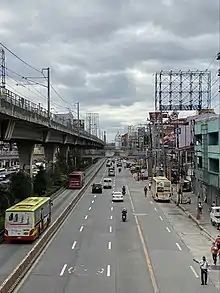
The LRT Line 1 has two stations in the southern part of the city, namely: Monumento and 5th Avenue. Philippine National Railways also has a line, with its terminal at Samson Road, and passes through Caloocan railway station (the first railway station built in the city), 10th Avenue railway station, and 5th Avenue railway station. The currently under construction MRT Line 7 has also two under-construction stations located at the northern part of Caloocan, namely: Sacred Heart and Tala.
The city has an extensive network of roads, the most prominent being Epifanio de los Santos Avenue, which begins in the Monumento area. Quirino Highway, which connects Quezon City and eastern Bulacan, also traverses the northern part of Caloocan. The North Luzon Expressway's Operations and Maintenance Center and the motorway's Balintawak toll barrier are in the southern part of Caloocan. NLEX Harbor Link, its extension that connects it towards Navotas and Port of Manila, and the NLEX Connector project that connects Harbor Link with the City of Manila and Skyway also traverse Caloocan. The northern end of Skyway, which connects the North and South Luzon Expressways, is also found near NLEX's Balintawak toll plaza, with a possible connection to a future toll road leading to the New Manila International Airport.
Bus line Victory Liner Incorporated has its headquarters and terminal along Rizal Avenue Extension near the Monumento station.
Landmarks

The city's most celebrated landmark is the monument to the revolutionary Andrés Bonifacio, which stands on a roundabout where EDSA, MacArthur Highway, Samson Road, and Rizal Avenue Extension intersect. The memorial was erected in 1933 and consists of an obelisk with sculptures by National Artist Guillermo Tolentino. The monument marks the very first battle of the Philippine Revolution on August 3, 1896. Recent renovations have been made on the environs of the monument, including the Bonifacio Circle, its former site, and the Caloocan stretch of EDSA, which is 100 meters (330 ft) away from the landmark. The whole area is known as 'Monumento'.
The new Caloocan City Hall stands in a rectangular lot bordered by 8th and 9th Streets and 8th and 9th Avenues in Grace Park East in the southern part of the city. It replaced the old Caloocan City Hall, built in 1952, that stood at A. Mabini Street in the southern part across from San Roque Cathedral-Parish.[45][46][47] There is also the Caloocan City Hall North serving the northern part of the city, located along Zapote Street in Camarin. The city's District Office of the Bureau of Internal Revenue is along EDSA.
Other sites of historical importance identified by the city government include a lot in P. Zamora Street where the wife of Katipunan leader Andrés Bonifacio once resided; the heritage house of Gertrudes Sevilla, the owner of which is the nephew of Gregoria de Jesús;[48][45] Santa Quiteria Church in Baesa; and Our Lady of Grace Parish in 11th Avenue; La Loma Cemetery, the oldest cemetery in Manila; and Thai To Taoist Temple along 6th Avenue.
Police
The Caloocan City Police Station is under the parent agency National Capital Region Police Office's Northern Police District of the Philippine National Police. They were once recognized as the best police station for their contribution to the drug war during the administration of President Rodrigo Duterte.
However, the whole Caloocan city police force was recently sacked after a series of crimes, including killings and robberies, were committed by its members. However, instead of dismissing the erring police officers, they were scheduled to be retrained by then Philippine National Police Chief Ronald dela Rosa.[49]
Education

The city's lone public university is the University of Caloocan City (formerly Caloocan City Community College in 1971 and Caloocan City Polytechnic College in 1975). Other educational institutions offering tertiary education include University of the East Caloocan, Manila Central University, La Consolacion College-Caloocan, and La Consolacion College-Novaliches, Access Computer College Caloocan, AMA Computer College-Caloocan, STI Academic Center Caloocan, among others.
There are also several public and private schools catering to K–12, such as:
- Caloocan National Science and Technology High School (North Caloocan's first-ever science and technology high school; its students are admitted if they pass a competitive examination)
- Caloocan City Science High School
- Caloocan City Business High School
- Caloocan High School
- Amparo High School
- Maria Clara High School
- Philippine Cultural College (Annex)
- Holy Infant Montessori Center
- Northern Rizal Yorklin School
- St. Mary's Academy of Caloocan City
- Notre Dame of Greater Manila
- Antonio Luna High School (formerly Bagumbong High School-Annex)
- Camarin High School
- Tala High School
- Manuel Luis Quezon High School
- Sampaguita High School
- Cielito Zamora High School
- Bagong Silang High School
- National Housing Corporation High School (NHC HS)
- Genesis Christian Academy of Caloocan
- Kalayaan National High School
- Deparo High School
- Escuela de Sophia of Caloocan, Inc.
- Escuela San Gabriel de Arcangel Foundation, Inc.
- Colegio de San Gabriel of Caloocan, Inc.
- Guardian Angel School
- Horacio Dela Costa Elementary School
- Horacio Dela Costa High School
- Antonio Uy Tan Senior High School
- Saint Benedict School of Novaliches
- Saint Dominic Savio School of Caloocan City
- Academy of Saint Andrew Caloocan Inc.
- Immaculada Concepcion College
- Systems Plus Computer College
- St. Gabriel Academy
- Asian Institute of Computer Studies – Caloocan
- St. Clare College of Caloocan
- Mystical Rose School of Caloocan, Inc.
- Holy Angel School of Caloocan, Inc.
- St. Agnes Academy of Caloocan, Inc.
- St. Therese of Rose School,
- Young Achievers School of Caloocan
- St. Joseph College of Novaliches
- St. Raphaela Mary School of Caloocan
- Our Lady of Lourdes Catholic School
- Maranatha Christian Academy of Caloocan (Camarin)
- Ridgewood School of Caloocan
- Grace Park Elementary School
- Sampalukan Elementary School
- Libis Talisay Elementary School
- Kaunlaran Elementary School
- Lerma Elementary School
- Pag-Asa Elementary School
- Camarin Elementary School
- La Consolacion College
- Caloocan (South) Campus
- Novaliches (Deparo) Campus
Twin towns – sister cities
International
Gallery
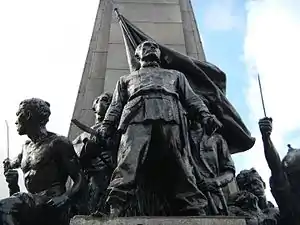
 San Roque Parish-Cathedral in Poblacion district
San Roque Parish-Cathedral in Poblacion district Old St. Pancratius Chapel in La Loma Cemetery
Old St. Pancratius Chapel in La Loma Cemetery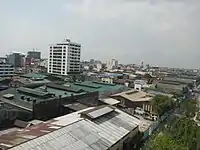 View of Grace Park from the new city hall
View of Grace Park from the new city hall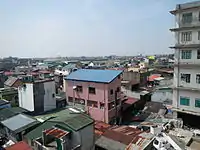 View of Barangays 15 and 16 from the old city hall
View of Barangays 15 and 16 from the old city hall Regional Trial Courts, Halls of Justice
Regional Trial Courts, Halls of Justice.jpg.webp) Vicariate of Our Lady of Grace, Diocesan Shrine of Our Lady of Grace, Roman Catholic Diocese of Kalookan
Vicariate of Our Lady of Grace, Diocesan Shrine of Our Lady of Grace, Roman Catholic Diocese of Kalookan Schools Division Office of Caloocan
Schools Division Office of Caloocan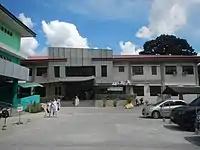
 Kalookan Cockpit Arena in Kaybiga
Kalookan Cockpit Arena in Kaybiga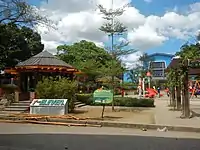
 Caloocan City North Medical Center in Camarin
Caloocan City North Medical Center in Camarin
Notable people
References
- City of Caloocan | (DILG)
- "2015 Census of Population, Report No. 3 – Population, Land Area, and Population Density" (PDF). Philippine Statistics Authority. Quezon City, Philippines. August 2016. ISSN 0117-1453. Archived (PDF) from the original on May 25, 2021. Retrieved July 16, 2021.
- Census of Population (2020). "National Capital Region (NCR)". Total Population by Province, City, Municipality and Barangay. Philippine Statistics Authority. Retrieved July 8, 2021.
- "PSA Releases the 2018 Municipal and City Level Poverty Estimates". Philippine Statistics Authority. December 15, 2021.
- "Comprehensive Land Use Plan Report, City of Caloocan (1995-2020) - Free Download PDF". kupdf.net.
- Republic Act No. 3278 (June 17, 1961). An Act Creating the City of Caloocan. Retrieved May 6, 2022.
- Republic Act No. 5502 (June 21, 1969). An Act Revising Republic Act Numbered Thirty-Two Hundred and Seventy-Eight Otherwise Known as the Charter of the City of Caloocan. Retrieved May 6, 2022.
- "Confusion over spelling: Caloocan or Kalookan?". The Manila Times. October 19, 2004. Retrieved April 2, 2020.
- Samonte, Severino (December 6, 2018). "Which is which, Caloocan or Kalookan?". Philippine News Agency. Retrieved April 2, 2020.
- Joaquin, Agapito. "The Role of Kalookan in the Nation's Quest for Freedom". Retrieved April 26, 2020.
- "History2". caloocancity.gov.ph. Archived from the original on February 14, 2021.
- "History of Caloocan City - El Pueblo de Caloocan Provincial de Manila | Metro Manila Philippines". yodisphere.com. August 2021. Retrieved May 6, 2022.
- Act No. 942 (June 11, 1901). An Act Extending the Provisions of the Provincial Government Act to the Province of Rizal. Retrieved June 12, 2022.
- Act No. 942 (October 12, 1903). An Act Reducing the Thirty-Two Municipalities of the Province of Rizal to Fifteen. Retrieved May 12, 2022.
- Executive Order No. 400, s. 1942 (January 1, 1942). Creating the City of Greater Manila. Retrieved August 24, 2022.
- "Historical Background". DENR - Environment Management Bureau - National Capital Region. Retrieved May 28, 2022.
- Executive Order No. 58, s. 1945 (July 26, 1945). Reducing the Territory of the City of Greater Manila. Retrieved August 24, 2022.
- Presidential Decree No. 824 (November 7, 1975). Creating the Metropolitan Manila and the Metropolitan Manila Commission and for Other Purposes. Archived from the original on March 12, 2016. Retrieved July 10, 2020.
- Philippine Commission of the Census, Census of the Philippines, 1939, vol. 1, part 4: Rizal (Manila: Bureau of Printing, 1940), p. 5
- Commonwealth Act No. 502 (October 12, 1939). An Act to Create Quezon City. Retrieved April 21, 2022.
- Republic Act No. 392 (June 18, 1949). An Act to Amend Section Three of Commonwealth Act Numbered Five Hundred and Two, as Amended, Redefining the Boundaries of Quezon City. Retrieved April 21, 2022.
- "Caloocan City Citizen's Charter" (PDF). City of Caloocan. Retrieved May 6, 2022.
- "Climate change action plan" (PDF). caloocancity.gov.ph. 2016. Archived from the original (PDF) on July 17, 2019. Retrieved July 11, 2020.
- "Caloocan: Average Temperatures and Rainfall". Meteoblue. Retrieved May 13, 2020.
- "Duterte splits Caloocan into 3 districts". The Philippine STAR.
- Republic Act No. 11545 (May 26, 2021). An Act Reapportioning the First Legislative District of the City of Caloocan into Two (2) Legislative Districts. Retrieved April 10, 2022.
- Republic Act No. 6714 (February 28, 1989). An Act merging, dividing, and/or reviving the different barangays in Caloocan City and for other purposes. Retrieved July 26, 2019.
- Census of Population (2015). "National Capital Region (NCR)". Total Population by Province, City, Municipality and Barangay. Philippine Statistics Authority. Retrieved June 20, 2016.
- Bajo, Ramil; Galupo, Rey (September 17, 2013). "Mayor supports move to split Caloocan barangay into seven". The Philippine Star. Retrieved April 29, 2020.
- Republic Act No. 1713 (June 21, 1957). An Act to Convert the Sitio of Bagbaguin, Municipality of Caloocan, Province of Rizal, into a Barrio to be known as Barrio Bagbaguin of the Same Municipality and Separating it from the Barrio of Caybiga of the Same Municipality. Retrieved June 12, 2012.
- "Home". caloocancity.gov.ph.
- "Local shelter plan" (PDF). www.caloocancity.gov.ph. Retrieved July 11, 2020.
- Census of Population and Housing (2010). "National Capital Region (NCR)" (PDF). Total Population by Province, City, Municipality and Barangay. National Statistics Office. Retrieved June 29, 2016.
- Censuses of Population (1903–2007). "National Capital Region (NCR)". Table 1. Population Enumerated in Various Censuses by Province/Highly Urbanized City: 1903 to 2007. National Statistics Office.
- "Province of Metro Manila, 3rd (Not a Province)". Municipality Population Data. Local Water Utilities Administration Research Division. Retrieved December 17, 2016.
- "Poverty incidence (PI):". Philippine Statistics Authority. Retrieved December 28, 2020.
- "Estimation of Local Poverty in the Philippines" (PDF). Philippine Statistics Authority. November 29, 2005.
- "2003 City and Municipal Level Poverty Estimates" (PDF). Philippine Statistics Authority. March 23, 2009.
- "City and Municipal Level Poverty Estimates; 2006 and 2009" (PDF). Philippine Statistics Authority. August 3, 2012.
- "2012 Municipal and City Level Poverty Estimates" (PDF). Philippine Statistics Authority. May 31, 2016.
- "Municipal and City Level Small Area Poverty Estimates; 2009, 2012 and 2015". Philippine Statistics Authority. July 10, 2019.
- "PSA Releases the 2018 Municipal and City Level Poverty Estimates". Philippine Statistics Authority. December 15, 2021.
- "Victoria Wave Special Economic Zone". Retrieved April 10, 2022.
- Dioquino, Aaron Homer (August 11, 2023). "Caloocan LGU to build new city hall". Manila Bulletin. Retrieved September 5, 2023.
- "CALOOCAN CITY MEDIUM TERM". yumpu.com.
- Melican, Nathan (November 3, 2013). "Caloocan City eyes new building to replace 61-year-old city hall". INQUIRER.net. Retrieved September 5, 2023.
- Garcia, Danilo (December 17, 2017). "Caloocan City Hall lilipat na ng bagong gusali". Pilipino Star Ngayon (in Tagalog). Retrieved September 5, 2023.
- Cayabyab, Marc Jayson (June 16, 2019). "Caloocan elderly remember Bonifacio's wife". The Philippine Star. Retrieved April 30, 2020.
- "NCRPO relieves Caloocan City police force". Philstar.com. September 15, 2017. Retrieved September 6, 2023.
- "Sister cities". Manila Bulletin. Retrieved August 30, 2016.
External links
- Official website
- Philippine Standard Geographic Code
- History of Caloocan, Philippines
 Geographic data related to Caloocan at OpenStreetMap
Geographic data related to Caloocan at OpenStreetMap


.jpg.webp)
.jpg.webp)
(2017-08-13).jpg.webp)
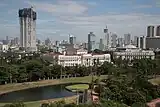
.jpg.webp)
(2018-05-27).jpg.webp)